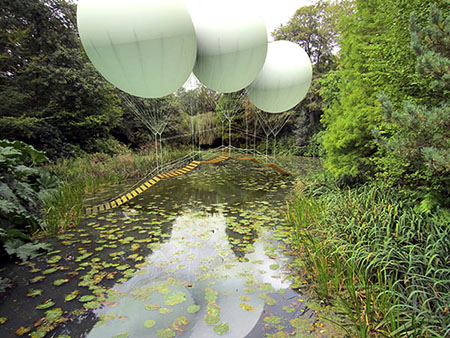Tatton Park Biennial 2012

The persistent overhead rumble of jet engines is a constant reminder that the otherwise tranquil Tatton Park lies close to the Manchester Airport flight path. Yet what may present a minor irritation to visitors at this historic National Trust property provides a pertinent aural accompaniment to this year’s Tatton Park Biennial, which – for its third edition, titled ‘Flights of Fancy’ – revolves around the theme of flight. Tatton’s association with aviation reaches far beyond its proximity to an international airport: Maurice Egerton, the estate’s last lord and former owner, was a keen experimental aviator and, during World War II, the estate became a dropping zone for trainee paratroopers. With these histories in view, returning curators Danielle Arnaud and Jordan Kaplan have commissioned 16 new temporary art works, which lie scattered across Tatton’s formidable 18th-century mansion, gardens and parkland.
The dream of flight is elegantly evoked by Olivier Grossetête’s Pont de Singe (Rope Bridge, all works 2012), one of the exhibition’s strongest pieces. Hovering over the quiet waters of the Japanese Garden, a precarious wooden rope bridge is held aloft by three enormous helium-filled balloons that billow in the breeze. Yet for all its reverie, Grossetête’s whimsical installation avoids descending into mere spectacle by pointing to the transformative potential of imagination and the fragility of human endeavour – themes that effectively encapsulate the essence of this year’s Biennial. Elsewhere, dreams turn to nightmares in Simon Faithfull’s video ESY1899: Re-enactment for a Future Scenario, which is displayed in an incongruous shipping container. Filmed in Manchester Airport’s fire simulator, a silver-suited commuter is seen boarding a blackened, truncated plane, to find his seat amid raging flames. Terrifying and farcical, Faithfull’s vision of a future in which air travel is a distant memory is a sobering reminder of the ever-present potential for catastrophe.
As with previous editions of the biennial, the colourful figure of Lord Egerton provides a point of departure for some of the most engaging commissions. His early experiments with radio are echoed by Charbel Ackermann’s sound work Dead Cat, which resembles a huge boom microphone suspended from trees in the arboretum. Broadcasting a selection of ambient soundtracks into the woods, the programme includes a poignant 1942 BBC recording of nightingales, which inadvertently caught the rumble of Allied bombers overhead. Inside the mansion, botanical books from Egerton’s extensive library form the basis of Sarah Woodfine’s Recipe for a Kiss of Shame: exquisite pencil drawings showing various hallucinatory ingredients required for a witch’s flying potion adorn wooden elements approximating chemical flasks.
Alluding to the artist’s adolescent experiments with mind-altering substances in Tatton’s grounds, Jem Finer’s ¡Arriba! comprises a quirky virtual trip from the confines of the orchard to the far reaches of outer space. Installed in a bantam caravan with windows replaced by LCD screens, Finer’s hammy montage of video and computer graphics transforms the cosy camper into a makeshift flight simulator that, like several works here, makes up for its lack of criticality by ramping up the entertainment factor. Indeed, unreflective whimsy seems almost to have been encouraged this year and the exhibition’s punning title – ‘Flights of Fancy’ – ostensibly serves to foreclose intellectual rigour. Sited in adjacent woodland, the cosmic theme continues with David Cotterrell’s mesmerizing planetarium, In Other Worlds, I Love You. Data streams supplied by the nearby Jodrell Bank astrophysics centre project images of deep space onto the interior of an enigmatic walk-in sphere, revealing an ancient galactic history. Appearing like some interplanetary vessel, Cotterrell’s project exudes far more conviction than Dinu Li’s dismal crash-landed flying saucer, VEX, which, lying just short of the mansion house, appears to have eloped from Tatton’s adventure playground.
The obtrusive presence of international air traffic over Tatton’s skies is mirrored by the Biennial itself, in which the acute tension between the nature of a listed tourist attraction and the placing of contemporary art works within its perimeter must necessarily be navigated with prudence. Yet one senses that the curators this year have chosen to play it safe. This is certainly not the ‘creative laboratory’ of the 2010 edition, with its experimentation, risk-taking and embracing of failure. The commissioning of art works that are at once sympathetic to their surroundings yet not compromised by them is, of course, a perennial challenge for projects such as this. Although the curators and artists have, on occasion, performed this tricky balancing act with aplomb, the exhibition lacks something of the critical edge found in previous editions. While this is certainly Arnaud and Kaplan’s most cohesive Tatton Park Biennial to date, it is also their most genteel and one is left wondering if a National Trust property can ever really play host to truly ambitious and critical curatorial endeavours.
















